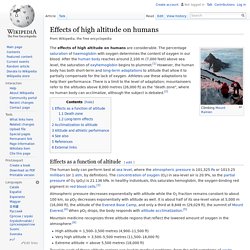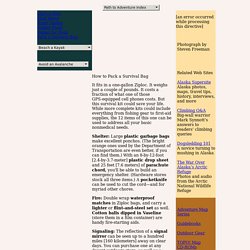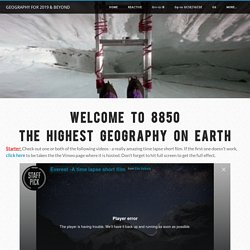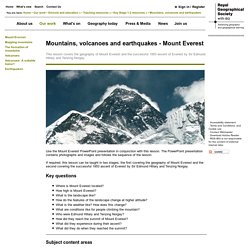

Tasks. PUBLIC SERVICE BROADCASTING - Everest. World's Highest BASE Jump - Flying from Mt. Everest. The Himalayan - Mt.Everest Base Camp trek HD Time Lapse. Everest -A time lapse short film on Vimeo: Couch Mode. Effects of high altitude on humans. Effects as a function of altitude[edit] Atmospheric pressure decreases exponentially with altitude while the O2 fraction remains constant to about 100 km, so pO2 decreases exponentially with altitude as well.

It is about half of its sea-level value at 5,000 m (16,000 ft), the altitude of the Everest Base Camp, and only a third at 8,848 m (29,029 ft), the summit of Mount Everest.[4] When pO2 drops, the body responds with altitude acclimatization.[5] Mountain medicine recognizes three altitude regions that reflect the lowered amount of oxygen in the atmosphere:[6] High altitude = 1,500–3,500 metres (4,900–11,500 ft)Very high altitude = 3,500–5,500 metres (11,500–18,000 ft)Extreme altitude = above 5,500 metres (18,000 ft) Travel to each of these altitude regions can lead to medical problems, from the mild symptoms of acute mountain sickness to the potentially fatal high altitude pulmonary edema (HAPE) and high altitude cerebral edema (HACE).
Death zone[edit] Long-term effects[edit] Mount Everest: Packing List for the World’s Tallest Peak. What do you pack for the world’s tallest peak?

Here’s what ski mountaineer Hilaree O’Neill is bringing to Everest, where she is part of our spring 2012 expedition sponsored by National Geographic and The North Face (learn more about the expedition). Though her main objective is to summit via the Southeast Ridge with her teammates, she is bringing her skis on the expedition for a little exploring, if time permits. The team, led by Conrad Anker, has just arrived in Nepal. Follow their progress at natgeo.com/oneverest and on Twitter at #oneverest. See how much gear has changed in expedition gear since Sir Edmund Hillary’s first ascent in 1953 in our Everest Climbing Gear—Then and Now photo gallery. Hilaree O’Neill’s Spring 2012 Everest Packing List Apparel North Face Himalaya suit North Face Prism Optimus Jacket North Face Redpoint Pants North Face Aurora Tights Wool base layers Darn Tough Vermont socks, merino wool 2XU Compression socks 2XU Compression tights Buffs.
National Geographic Survival Basics: Survival Kit. How to Pack a Survival Bag It fits in a one-gallon Ziploc.

It weighs just a couple of pounds. It costs a fraction of what one of those GPS-equipped cell phones costs. But this survival kit could save your life. While more complete kits could include everything from fishing gear to first-aid supplies, the 12 items of this one can be used to address all your basic nonmedical needs. Shelter: Large plastic garbage bags make excellent ponchos. Fire: Double wrap waterproof matches in Ziploc bags, and carry a lighter or flint-and-steel set as well. Signaling: The reflection of a signal mirror can be seen up to a hundred miles [160 kilometers] away on clear days. Water: One bottle of iodine-based purification tablets can treat up to 25 quarts [23.7 liters] of water. Whatever is in your survival kit, says expert Byron Kerns, the fundamental rule is: "You've got to keep it with you. " Learn More: —Laurence Gonzales Next Tip: How to Beach a Kayak >>
Extensions 1 - 8850 Top of the World - Geography for 2015. Welcome to 8850 The Highest Geography On Earth Starter: Check out one or both of the following videos - a really amazing time lapse short film.

If the first one doesn't work, click here to be taken the the Vimeo page where it is hosted. Don't forget to hit full screen to get the full effect. Nearly 60 years to the day after the first ascent up Mount Everest, Russian extreme sport star Valery Rozov (48) flew off the north face of Mount Everest - the world's highest BASE jump ever - 7220 meters (23,688ft) above sea level. Where is Everest & What's it Like? Extensions 2 - Mount Everest. This lesson covers the geography of Mount Everest and the successful 1953 ascent of Everest by Sir Edmund Hillary and Tenzing Norgay.

Use the Mount Everest PowerPoint presentation in conjunction with this lesson. The PowerPoint presentation contains photographs and images and follows the sequence of the lesson. If required, this lesson can be taught in two stages; the first covering the geography of Mount Everest and the second covering the successful 1953 ascent of Everest by Sir Edmund Hillary and Tenzing Norgay. Key questions Where is Mount Everest located? Subject content areas Locational knowledge: Pupils develop contextual knowledge of the location of globally significant places Place knowledge: Communicate geographical information in a variety of ways, including writing at length.